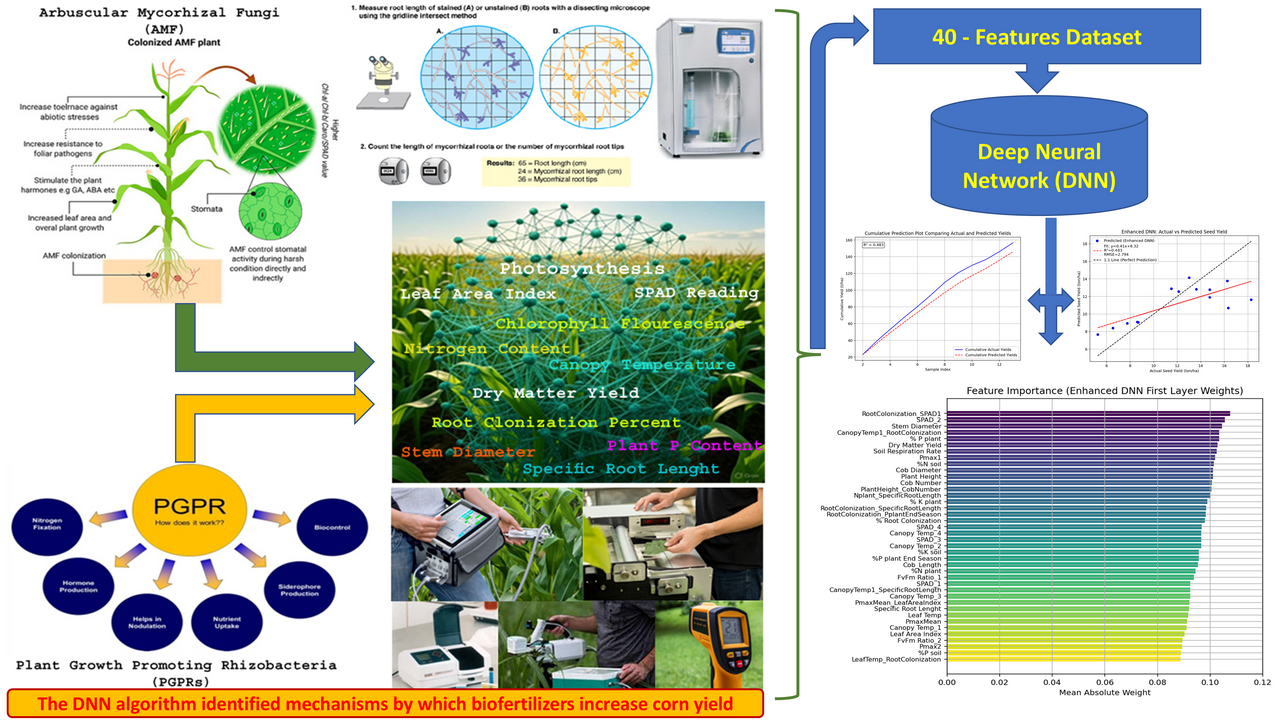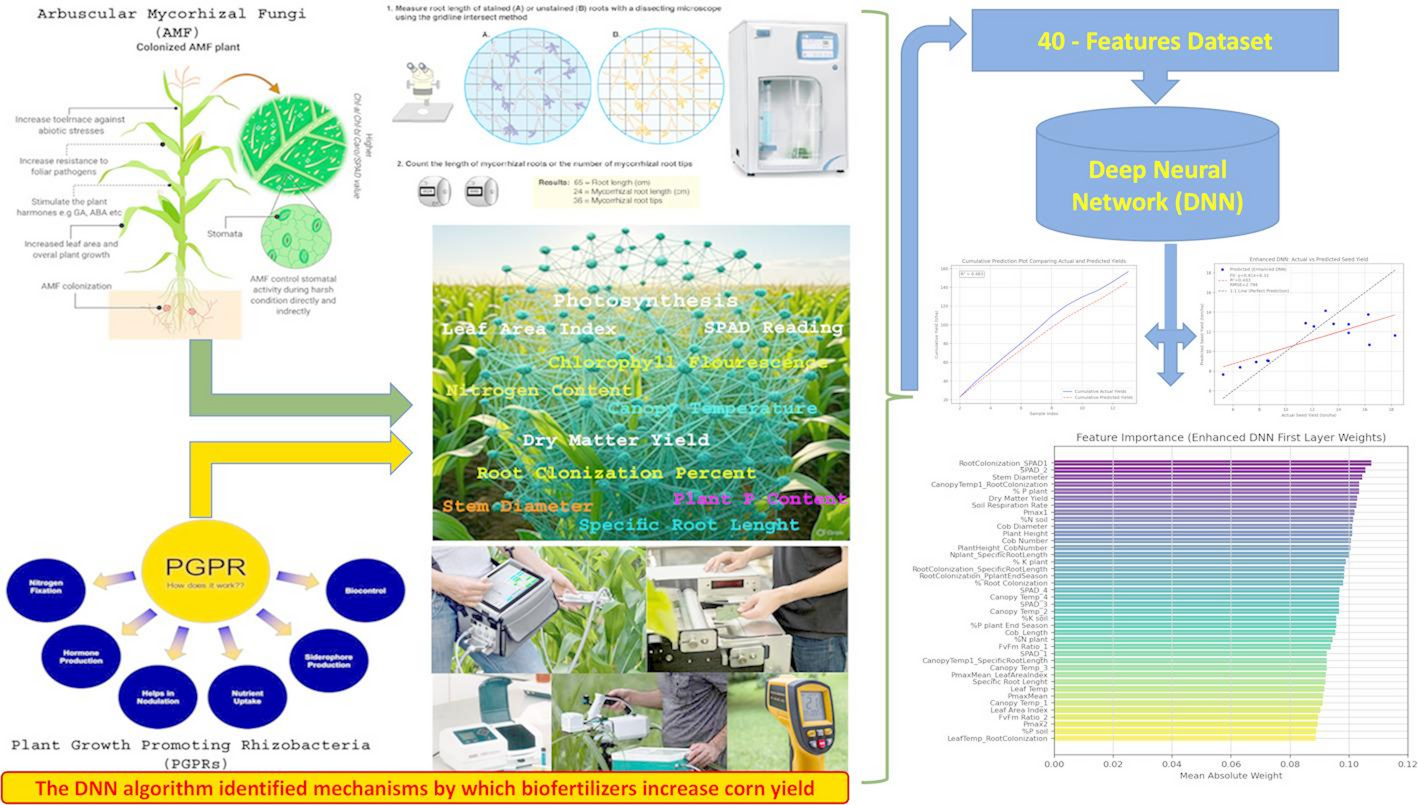Decoding Corn Yield Efficiency: How Deep Neural Networks Can Help Build a More Sustainable Future
Published in Earth & Environment, Ecology & Evolution, and Microbiology

The degradation of fundamental natural resources, the decline in biodiversity, the ever-growing population, and the rise of cultural and geopolitical conflicts have collectively rendered our planet’s environment more unstable than ever before. For the first time in human history, our shared ecosystem faces the tangible risk of total collapse. In this context, it has become imperative to reduce the environmental costs of food production while simultaneously ensuring that the growing global population can access food in safer and healthier ways. One of the most essential pathways toward this goal lies in improving resource-use efficiency on farms. By enhancing how plants absorb and utilize water, nutrients, and energy—and by understanding the eco-physiological pathways through which these resources are converted into food—we can minimize input usage while ensuring the sustainable exploitation of soil, water, and plant resources.
In this study, titled “Enhanced Deep Neural Network with Interaction Features for Corn Seed Yield Prediction: Uncovering AgroEcophysiological Relationships,” published in Discover Agriculture (Springer Nature), we sought to bridge the gap between ecophysiology and artificial intelligence to improve the sustainability of agricultural systems. Our motivation was rooted in a simple yet powerful question: Can we teach machines not only to predict yield but also to understand the biological logic behind it?
The Motivation Behind the Work
Modern agriculture generates enormous volumes of data—from soil nutrients and microbial activity to canopy temperature and rainfall patterns. However, these data streams often remain fragmented and underutilized. Conventional statistical models struggle to capture the complex, nonlinear interactions between biological and environmental processes that determine crop yield. At the same time, purely black-box AI models, while powerful, often lack interpretability, making them difficult to trust or apply in real-world agronomic decision-making.
This tension between complexity and interpretability became the foundation of our research. We aimed to create a deep learning framework capable of learning hidden patterns among agronomic variables while also providing explainable insights into the ecophysiological mechanisms underlying crop productivity.
Our Approach: From Data to Discovery
We developed an Enhanced Deep Neural Network (EDNN) architecture that integrates interaction features—mathematical representations of how two or more environmental or physiological variables jointly influence yield outcomes. These interaction features allow the network to model cross-effects such as:
-
how soil phosphorus availability interacts with canopy temperature,
-
how microbial colonization modifies nutrient uptake efficiency,
-
and how rainfall and solar radiation jointly affect kernel formation.
By incorporating such features, our EDNN acts not just as a prediction tool but as a digital reflection of the plant’s biological logic.
The model was trained and validated on large-scale experimental data from corn fields subjected to different biofertilizer treatments (including arbuscular mycorrhizal fungi and plant growth-promoting rhizobacteria). These treatments are known to influence resource-use efficiency and root–soil interactions—a critical component of sustainable agriculture.
Overcoming Challenges
Developing this framework was far from straightforward.
One major challenge was data heterogeneity—each dataset came from experiments under different climatic and soil conditions. Normalizing and harmonizing these variables without losing their biological meaning required both agronomic expertise and computational precision.
Another difficulty was avoiding overfitting while preserving model interpretability. To address this, we incorporated dropout layers, early stopping, and SHAP (SHapley Additive exPlanations) analysis to ensure that the model’s predictions were biologically sound and explainable.
But perhaps the greatest challenge was conceptual: finding a way to speak both languages—the language of ecology and the language of algorithms—and allowing them to meet in a space where both make sense.
Key Findings and Insights
The EDNN achieved a substantial improvement in yield prediction accuracy compared to traditional machine learning models. More importantly, its explainability revealed novel agroecophysiological relationships that had not been previously quantified.
For example, the model uncovered that under biofertilizer application, soil respiration and canopy temperature exhibit a compensatory dynamic—when microbial activity enhances nutrient mineralization, plants require less transpirational cooling to maintain optimal photosynthetic performance. Such insights highlight the bio-efficiency mechanisms through which natural microbial associations can replace or complement chemical inputs.
This fusion of AI interpretability and ecophysiological reasoning offers a pathway toward “intelligent sustainability”—a future where technology helps us understand nature’s own logic rather than override it.
Why It Matters
Global agriculture stands at a crossroads. The challenge of feeding nearly 10 billion people by 2050 cannot be met with incremental improvements alone. What we need are transformative frameworks that connect disciplines—bringing together biology, data science, and environmental ethics.
Our research contributes a step in that direction. It shows that artificial intelligence, when guided by ecological principles, can become a tool for biological discovery rather than just automation. By learning from the plant’s inner logic, we can move toward a form of agriculture that is both productive and regenerative.
Looking Ahead
This work opens the door to a new generation of hybrid models—systems that combine deep learning, explainable AI, and ecophysiological simulation. The next step is to apply similar frameworks to multi-crop systems, assess regional adaptation strategies, and develop decision-support tools for farmers in arid and semi-arid regions.
Ultimately, this study is not just about algorithms or datasets; it’s about a vision. A vision where data-driven intelligence becomes an ally of ecological wisdom—helping humanity cultivate food systems that sustain both people and the planet.
Follow the Topic
-
Discover Agriculture

This journal covers basic science and applied research relating to the agricultural sector in areas such as crop and soil sciences, environmental science, and advances in relevant technologies.
Related Collections
With Collections, you can get published faster and increase your visibility.
Biological control agents mediate plant microbiome for plant health and protection: A blow of air for sustainable agriculture
The global demand for reducing pesticide residues in agricultural produce has increased significantly. Biopesticides and biological control agents (BCAs) agents, when used strategically alongside conventional synthetic pesticides, offer an effective solution for managing agricultural pests while minimizing pesticide residues. Plant growth-promoting biocontrol agents (PGPBCAs) are characterized by three key traits: plant growth promotion, antagonism effects, and induced systemic resistance (ISR). These PGPBCAS employed direct and indirect mechanisams to fascilate plant health and physiology in challenging circumstances. Recently, plant-associated microorganisms have been coined as a second functional genome that exhibits significant variability in terms of diversity, abundance, structure, and function. Over the past two decades, it has been demonstrated that microbial resources play a significant role in attaining the objective of sustainable plant growth and more environmentally friendly treatments for plant diseases. However, at the same time, the biopesticides also encountered numerous challenges in field conditions. The desired function can be influenced by both abiotic factors and biotic , especially interactions with pathogens. A pressing necessity exists to comprehend and advance scientific understanding of the plant microbiome and its interaction with both abiotic and biotic factors. This can be achieved by employing complex molecular, biochemical, and metabolite signaling and response mechanisms to sustain plant growth, protection, and productivity for a continuously growing human population.
Keywords: Pesticide residue reduction; Biopesticides; Biological control agents (BCAs); Plant growth-promoting biocontrol agents (PGPBCAs); Antagonism effects; Induced systemic resistance (ISR); Plant microbiome; Microbial resources; Sustainable plant growth; Abiotic and biotic interactions; Molecular signaling; Plant disease management
This Collection supports and amplifies research related to SDG 2.
Publishing Model: Open Access
Deadline: Jun 01, 2026
Climate-smart Agriculture: Approaches and Practices
Climate-smart agriculture was first defined in 2010 by Food and Agriculture Organization (FAO) of the United Nations as “an approach that helps guide actions to transform agricultural production systems towards green and climate resilient practices.” It refers to a set of sustainable farming methods designed to enhance the productivity and resilience of agricultural production systems that have been affected by climate change. Climate-smart agriculture aims to simultaneously achieve the three outcomes of increased productivity, enhanced resilience, and reduced emissions. In the past decade, integrated, holistic approaches for managing cropland, livestock, forests, and fisheries have been developed by researchers and practiced by agricultural practitioners to sustain and increase crop productivity and yield, enhance resilience to environmental changes, and reduce greenhouse gas emissions.
Keywords: soil health, plant breeding, biochar, carbon sequestration, agrivoltaics, greenhouse gas emissions, climate change, sustainable agriculture
This Collection supports and amplifies research related to SDG 2, SDG 7, SDG 12, and SDG 13.
Publishing Model: Open Access
Deadline: Dec 31, 2025




Please sign in or register for FREE
If you are a registered user on Research Communities by Springer Nature, please sign in